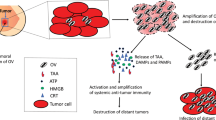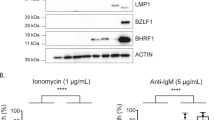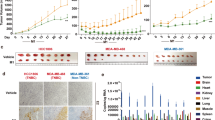Abstract
Oncolytic viruses are attractive cancer therapeutics because of their unique mechanisms of tumor cell targeting and the absence of toxic side effects associated with current treatments. Bovine herpesvirus type 1 (BHV-1) is a species-specific herpesvirus that fails to induce cytopathic effects in normal human cells, but is capable of infecting and killing a variety of immortalized and transformed human cell types, including human breast tumor cell lines from luminal, basal A and basal B subtypes, representing a variety of receptor expression profiles. BHV-1 is capable of initiating replication in and killing both bulk and side population cells, the latter of which have enhanced tumor-initiating capacity. Despite the lack of a productive infection or secretion of cytotoxic factors, BHV-1 infection decreases cellular viability in long-term culture following low multiplicity of infection. Moreover, BHV-1-infected MCF7 cells are significantly diminished in their capacity to form tumors in vivo. Overall, these studies suggest that oncolytic BHV-1 targets bulk breast cancer cells and cancer-initiating cells from luminal and basal subtypes by a novel mechanism that is not contingent upon cellular receptor expression status.
This is a preview of subscription content, access via your institution
Access options
Subscribe to this journal
Receive 12 print issues and online access
$259.00 per year
only $21.58 per issue
Buy this article
- Purchase on Springer Link
- Instant access to full article PDF
Prices may be subject to local taxes which are calculated during checkout






Similar content being viewed by others
References
Cervantes-Garcia D, Ortiz-Lopez R, Mayek-Perez N, Rojas-Martinez A . Oncolytic virotherapy. Ann Hepatol 2008; 7: 34–45.
Vaha-Koskela MJ, Heikkila JE, Hinkkanen AE . Oncolytic viruses in cancer therapy. Cancer Lett 2007; 254: 178–216.
Markert JM, Liechty PG, Wang W, Gaston S, Braz E, Karrasch M et al. Phase Ib trial of mutant herpes simplex virus G207 inoculated pre-and post-tumor resection for recurrent GBM. Mol Ther 2009; 17: 199–207.
Senzer NN, Kaufman HL, Amatruda T, Nemunaitis M, Reid T, Daniels G et al. Phase II clinical trial of a granulocyte-macrophage colony-stimulating factor-encoding, second-generation oncolytic herpesvirus in patients with unresectable metastatic melanoma. J Clin Oncol 2009; 27: 5763–5771.
Geevarghese SK, Geller DA, de Haan HA, Horer M, Knoll AE, Mescheder A et al. Phase I/II study of oncolytic herpes simplex virus NV1020 in patients with extensively pretreated refractory colorectal cancer metastatic to the liver. Hum Gene Ther 2010; 21: 1119–1128.
Nakao A, Kasuya H, Sahin TT, Nomura N, Kanzaki A, Misawa M et al. A phase I dose-escalation clinical trial of intraoperative direct intratumoral injection of HF10 oncolytic virus in non-resectable patients with advanced pancreatic cancer. Cancer Gene Ther 2011; 18: 167–175.
Campadelli-Fiume G, Cocchi F, Menotti L, Lopez M . The novel receptors that mediate the entry of herpes simplex viruses and animal alphaherpesviruses into cells. Rev Med Virol 2000; 10: 305–319.
Geraghty RJ, Krummenacher C, Cohen GH, Eisenberg RJ, Spear PG . Entry of alphaherpesviruses mediated by poliovirus receptor-related protein 1 and poliovirus receptor. Science 1998; 280: 1618–1620.
Masson D, Jarry A, Baury B, Blanchardie P, Laboisse C, Lustenberger P et al. Overexpression of the CD155 gene in human colorectal carcinoma. Gut 2001; 49: 236–240.
Sloan KE, Eustace BK, Stewart JK, Zehetmeier C, Torella C, Simeone M et al. CD155/PVR plays a key role in cell motility during tumor cell invasion and migration. BMC Cancer 2004; 4: 73.
Hushur O, Takashima Y, Matsumoto Y, Otsuka H . Restriction of bovine herpesvirus 1 (BHV-1) growth in non-permissive cells beyond the expression of immediate early genes. J Vet Med Sci 2004; 66: 453–455.
Rodrigues R, Cuddington B, Mossman K . Bovine herpesvirus type 1 as a novel oncolytic virus. Cancer Gene Ther 2009; 17: 344–355.
Abril C, Engels M, Liman A, Hilbe M, Albini S, Franchini M et al. Both viral and host factors contribute to neurovirulence of bovine herpesviruses 1 and 5 in interferon receptor-deficient mice. J Virol 2004; 78: 3644–3653.
Cheng X, O’Neill HC . Oncogenesis and cancer stem cells: current opinions and future directions. J Cell Mol Med 2009; 13: 4377–4384.
Hemmings C. . The elaboration of a critical framework for understanding cancer: the cancer stem cell hypothesis. Pathology 2010; 42: 105–112.
Kelly PN, Dakic A, Adams JM, Nutt SL, Strasser A . Tumor growth need not be driven by rare cancer stem cells. Science 2007; 317: 337.
Dean M, Fojo T, Bates S . Tumour stem cells and drug resistance. Nat Rev 2005; 5: 275–284.
Goodell MA, Brose K, Paradis G, Conner AS, Mulligan RC. . Isolation and functional properties of murine hematopoietic stem cells that are replicating in vivo. J Exp Med 1996; 183: 1797–1806.
Wu C, Alman BA . Side population cells in human cancers. Cancer Lett 2008; 268: 1–9.
Hirschmann-Jax C, Foster AE, Wulf GG, Nuchtern JG, Jax TW, Gobel U et al. A distinct ‘side population’ of cells with high drug efflux capacity in human tumor cells. Proc Natl Acad Sci USA 2004; 101: 14228–14233.
Zhou J, Wulfkuhle J, Zhang H, Gu P, Yang Y, Deng J et al. Activation of the PTEN/mTOR/STAT3 pathway in breast cancer stem-like cells is required for viability and maintenance. Proc Natl Acad Sci USA 2007; 104: 16158–16163.
Han JS, Crowe DL . Tumor initiating cancer stem cells from human breast cancer cell lines. Int J Oncol 2009; 34: 1449–1453.
Patrawala L, Calhoun T, Schneider-Broussard R, Zhou J, Claypool K, Tang DG . Side population is enriched in tumorigenic, stem-like cancer cells, whereas ABCG2+ and ABCG2− cancer cells are similarly tumorigenic. Cancer Res 2005; 65: 6207–6219.
Engelmann K, Shen H, Finn OJ . MCF7 side population cells with characteristics of cancer stem/progenitor cells express the tumor antigen MUC1. Cancer Res 2008; 68: 2419–2426.
Cariati M, Naderi A, Brown JP, Smalley MJ, Pinder SE, Caldas C et al. Alpha-6 integrin is necessary for the tumourigenicity of a stem cell-like subpopulation within the MCF7 breast cancer cell line. Int J Cancer 2008; 122: 298–304.
Fillmore CM, Kuperwasser C . Human breast cancer cell lines contain stem-like cells that self-renew, give rise to phenotypically diverse progeny and survive chemotherapy. Breast Cancer Res 2008; 10: R25.
Cripe TP, Wang PY, Marcato P, Mahller YY, Lee PW . Targeting cancer-initiating cells with oncolytic viruses. Mol Ther 2009; 17: 1677–1682.
Patel SA, Ndabahaliye A, Lim PK, Milton R, Rameshwar P . Challenges in the development of future treatments for breast cancer stem cells. Breast Cancer (London) 2010; 2: 1–11.
Marcato P, Dean CA, Giacomantonio CA, Lee PW . Oncolytic reovirus effectively targets breast cancer stem cells. Mol Ther 2009; 17: 972–979.
Bauerschmitz GJ, Ranki T, Kangasniemi L, Ribacka C, Eriksson M, Porten M et al. Tissue-specific promoters active in CD44+CD24−/low breast cancer cells. Cancer Res 2008; 68: 5533–5539.
Eriksson M, Guse K, Bauerschmitz G, Virkkunen P, Tarkkanen M, Tanner M et al. Oncolytic adenoviruses kill breast cancer initiating CD44+CD24−/low cells. Mol Ther 2007; 15: 2088–2093.
Lal R, Harris D, Postel-Vinay S, de Bono J . Reovirus: rationale and clinical trial update. Curr Opin Mol Ther 2009; 11: 532–539.
Dey M, Ulasov IV, Tyler MA, Sonabend AM, Lesniak MS . Cancer stem cells: the final frontier for glioma virotherapy. Stem Cell Rev 2011; 7: 119–129.
Ahtiainen L, Mirantes C, Jahkola T, Escutenaire S, Diaconu I, Osterlund P et al. Defects in innate immunity render breast cancer initiating cells permissive to oncolytic adenovirus. PLoS One 2010; 5: e13859.
Jenuwein T, Allis CD . Translating the histone code. Science 2001; 293: 1074–1080.
Sharma S, Kelly TK, Jones PA . Epigenetics in cancer. Carcinogenesis 2010; 31: 27–36.
Fernandez AF, Esteller M . Viral epigenomes in human tumorigenesis. Oncogene 2010; 29: 1405–1420.
Niller HH, Wolf H, Minarovits J. . Epigenetic dysregulation of the host cell genome in Epstein–Barr virus-associated neoplasia. Semin Cancer Biol 2009; 19: 158–164.
Adhya D, Basu A . Epigenetic modulation of host: new insights into immune evasion by viruses. J Biosci 2010; 35: 647–663.
Paschos K, Allday MJ . Epigenetic reprogramming of host genes in viral and microbial pathogenesis. Trends Microbiol 2010; 18: 439–447.
Cullen BR . Viruses and microRNAs: RISCy interactions with serious consequences. Genes Dev 2011; 25: 1881–1894.
Lu F, Stedman W, Yousef M, Renne R, Lieberman PM . Epigenetic regulation of Kaposi’s sarcoma-associated herpesvirus latency by virus-encoded microRNAs that target Rta and the cellular Rbl2-DNMT pathway. J Virol 2010; 84: 2697–2706.
Liu C, Tang DG . MicroRNA regulation of cancer stem cells. Cancer Res 2011; 71: 5950–5954.
Tsai HC, Baylin SB . Cancer epigenetics: linking basic biology to clinical medicine. Cell Res 2011; 21: 502–517.
Yamada Y, Watanabe A . Epigenetic codes in stem cells and cancer stem cells. Adv Genet 2010; 70: 177–199.
Melcher A, Parato K, Rooney CM, Bell JC . Thunder and lightning: immunotherapy and oncolytic viruses collide. Mol Ther 2011; 19: 1008–1016.
Mastrangelo MJ, Maguire HC, Lattime EC . Intralesional vaccinia/GM-CSF recombinant virus in the treatment of metastatic melanoma. Adv Exp Med Biol 2000; 465: 391–400.
Hanahan D, Weinberg RA . Hallmarks of cancer: the next generation. Cell 2011; 144: 646–674.
Herschkowitz JI, Zhao W, Zhang M, Usary J, Murrow G, Edwards D et al. Comparative oncogenomics identifies breast tumors enriched in functional tumor-initiating cells. Proc Natl Acad Sci USA 2012; 109: 2778–2783.
Shackleton M, Vaillant F, Simpson KJ, Stingl J, Smyth GK, Asselin-Labat ML et al. Generation of a functional mammary gland from a single stem cell. Nature 2006; 439: 84–88.
Acknowledgements
We thank Vikram Misra (University of Saskatchewan, Canada), Günther Keil (Friedrich-Loeffler-Institut, Germany) and Clinton Jones (University of Nebraska, USA) for reagents and Derek Cummings for technical assistance. AD held a Natural Sciences and Engineering Research Council studentship. BC holds a fellowship from the Canadian Breast Cancer Foundation. This work was sponsored by operating grants from the Cancer Research Society and the Canadian Cancer Society Research Institute (formerly the Canadian Breast Cancer Research Alliance). We acknowledge there are no financial conflicts of interest related to this research.
Author information
Authors and Affiliations
Corresponding author
Ethics declarations
Competing interests
The authors declare no conflict of interest.
Rights and permissions
About this article
Cite this article
Cuddington, B., Dyer, A., Workenhe, S. et al. Oncolytic bovine herpesvirus type 1 infects and kills breast tumor cells and breast cancer-initiating cells irrespective of tumor subtype. Cancer Gene Ther 20, 282–289 (2013). https://doi.org/10.1038/cgt.2013.18
Received:
Accepted:
Published:
Issue Date:
DOI: https://doi.org/10.1038/cgt.2013.18
Keywords
This article is cited by
-
Enhanced efficacy with azacytidine and oncolytic BHV-1 in a tolerized cotton rat model of breast adenocarcinoma
Molecular Therapy - Oncolytics (2015)
-
Oncolytic viruses as therapeutic cancer vaccines
Molecular Cancer (2013)



